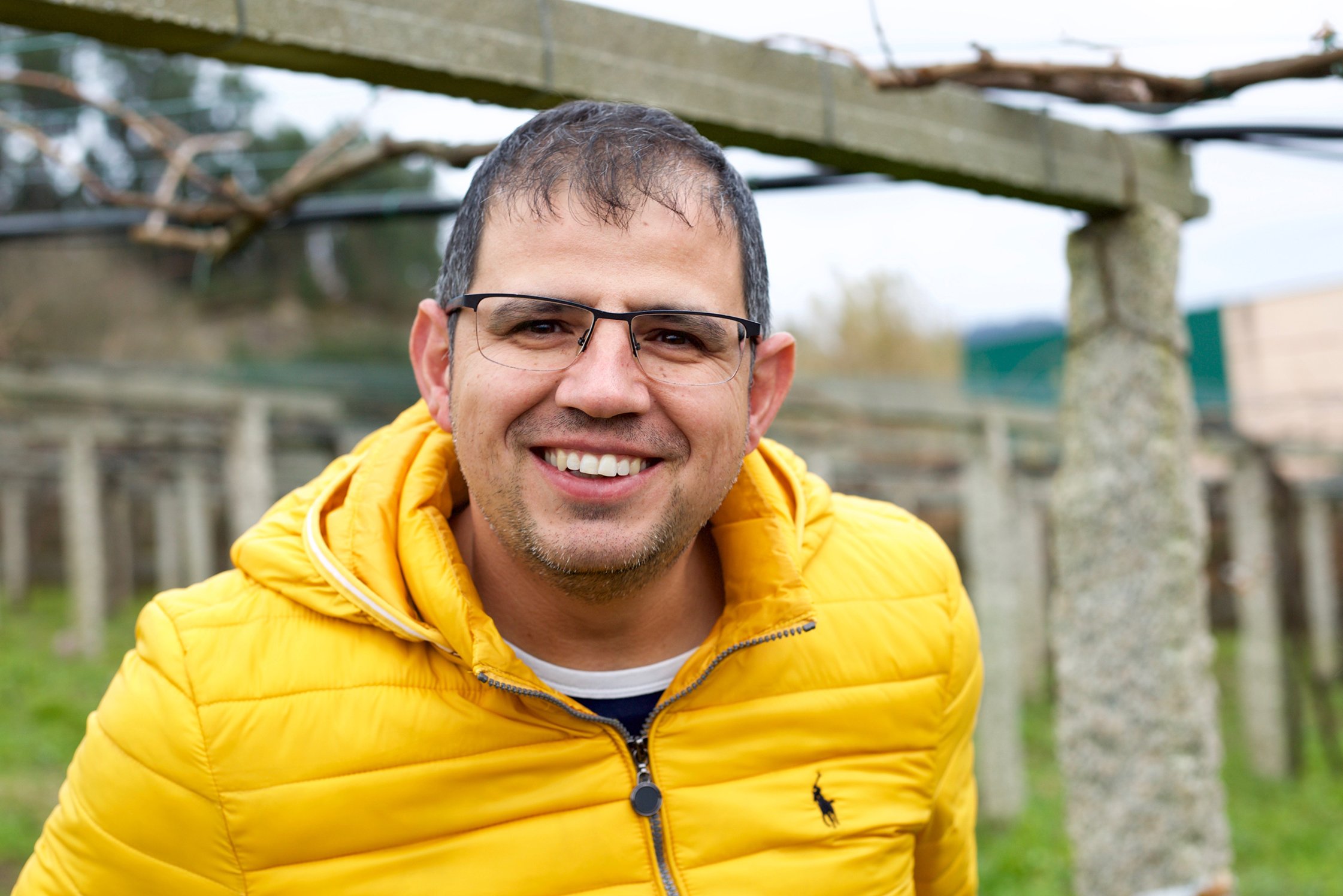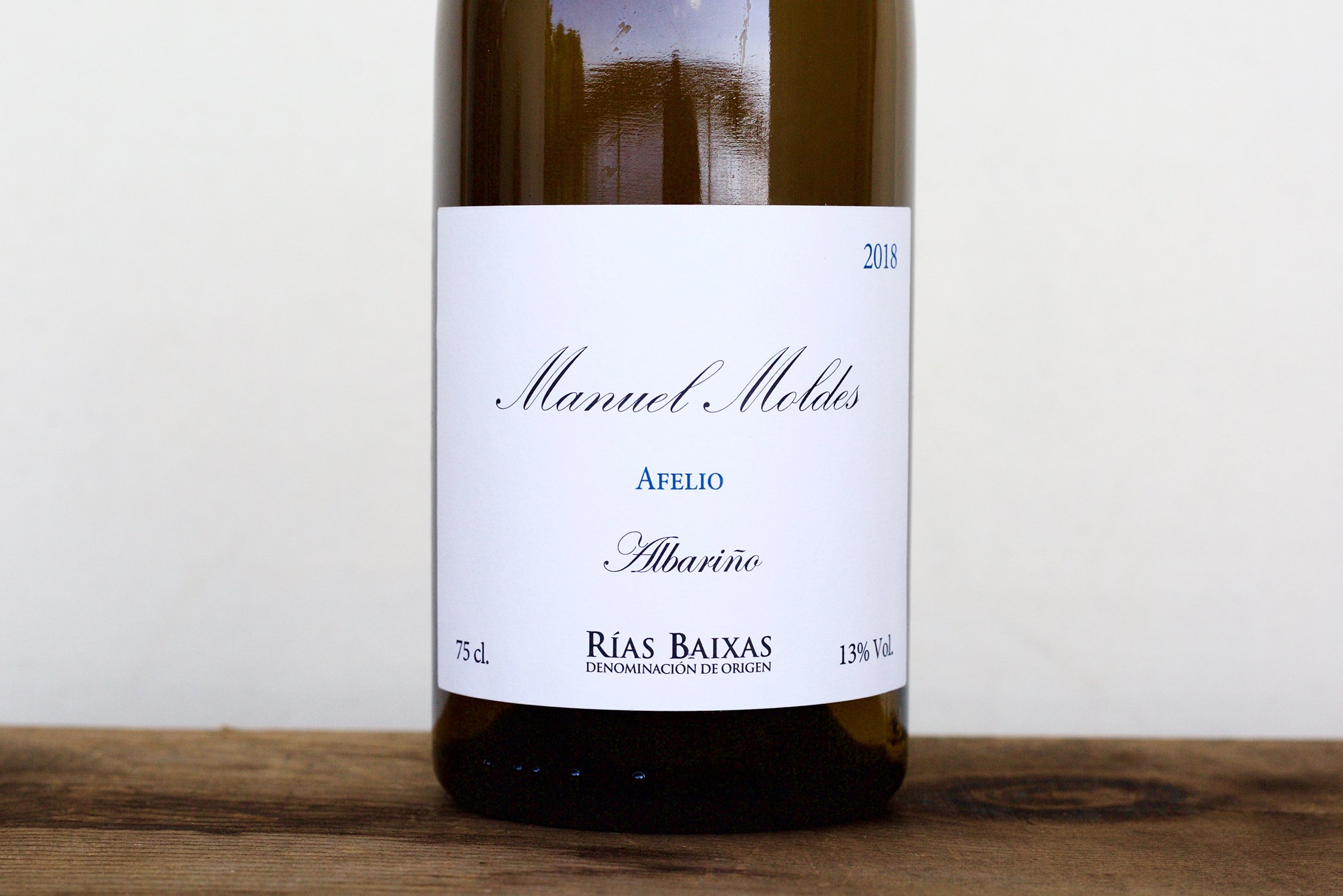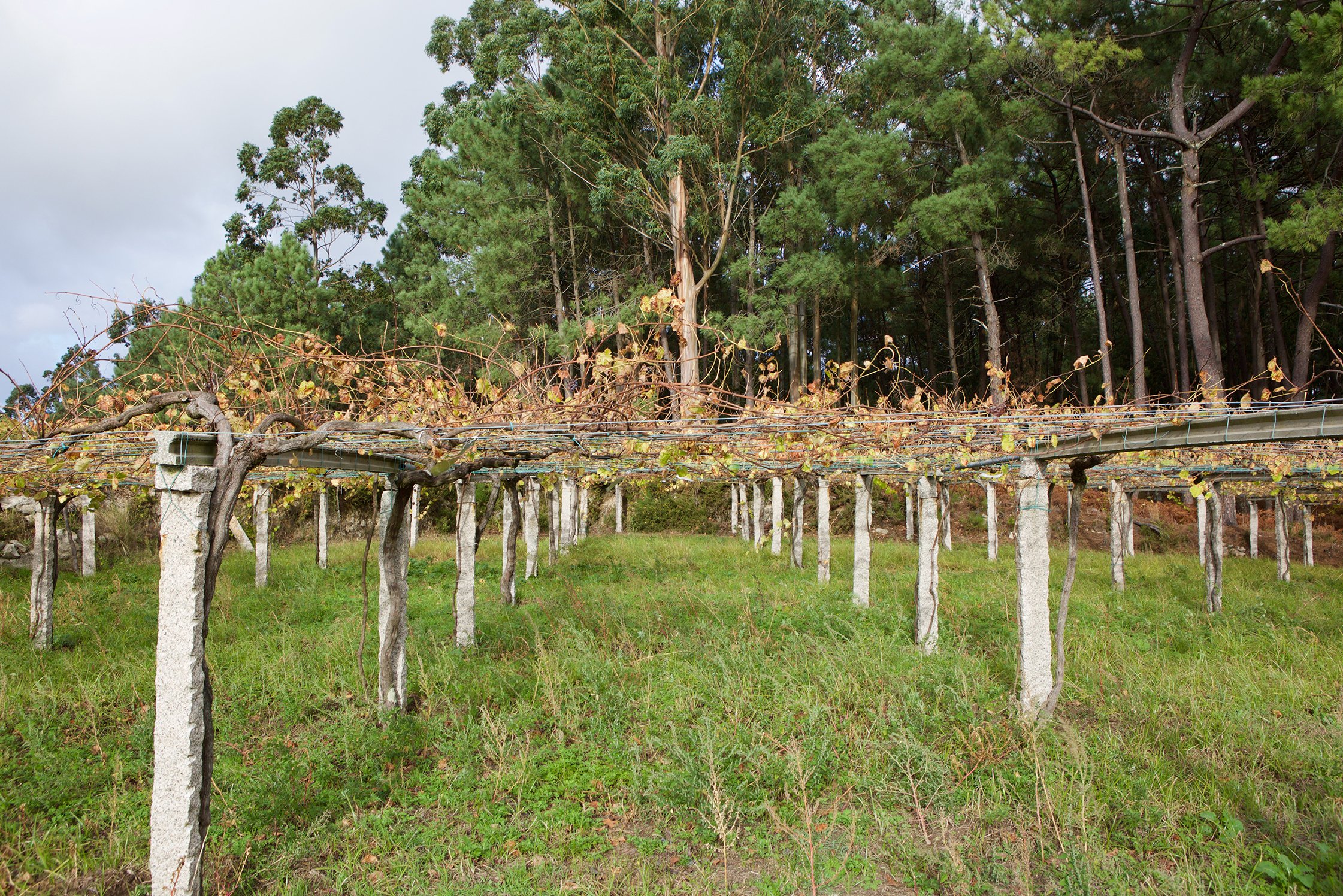While only in his early forties, Manuel Moldes appears to be well on his way to Yoda status by age fifty, although his peers throughout the expansive underground Spanish wine scene think he’s already there. One of the brightest lights in the rising tide of the Rías Baixas, his inspired talent for wine feels innate. And though his aptitude for deeply technical wine analysis is finely tuned, it’s his curiosity and open mind that guide him.
He and his fellow galego winemakers in the Rías Baixas seek out unique vineyards to source grapes and discover something new. Because there are few large plots owned by individual proprietors, these discoveries often come from small parcels overlooked and underutilized; many are in the backyard of a home winemaker, or growers who sell their fraction of a hectare of grapes to larger negociants.
Wine Details
Afelio is the embodiment of a classically styled Salnés Albariño: elegant tension, aromatic lift and the Atlantic influence with its salt, rain, ocean life, rock grinding waves, and cool brisk air. A set of tiny parcels scattered throughout the heart of the Val do Salnés between Meaño and Cambados grown on granite soils, the vines are trained on overhead pergolas supported by vertical granite posts with horizontal wood beams. Behind the veil of electricity the wine is simply crafted and the hand of the winemaker deft, but the interpretation is unique and subtly expressive. This wine represents the far western pole of electric whites across Europe, from the Loire Valley, Austria and down into the granite islands of Corsica and Sardinia. The fermentation is made in small stainless steel tanks and old French oak barrels. After fermentation it’s aged for eight months and then bottled.
A Capela de Aios is named after the tiny capela (church) in the small hamlet of Aios, located outside the Ría de Pontevedra. The vineyards sit on a mound of schist, a unique rock formation in a largely granite land, which Manuel says makes up 99.9% of all the vineyard area within the Val do Salnés. He’s drawn to the expression of wines from this hill, not only because they are rare, but because they bring a very different shape and dimension to Albariño than those grown on granite soils. This wine attacks and finishes like classic schist wines: a strongly mineral and metallic pressure directly on the back and side palate, almost skipping the front entirely by comparison. (Granite wines tend to be the opposite with more of a frontal attack and finish on the palate.) There it rests on the palate with dense salty characteristics and an electric feeling while remaining tight, dry and focused. Not surprisingly it has a strong relation in taste and feel to a Chenin Blanc grown on the schist soils of the Anjou—particularly a dry Chenin from the Côteaux du Layon. It’s fermentated with natural yeasts and aged in 500-700-liter neutral French oak barrels for nine to eleven months, depending on the vintage.
An embodiment of all terroir elements of the Rías Baixas, the Acios Mouros red blend rises above its grapes to express its cold and wet climate, the freshness of the forests and countryside, the ocean wind and metal and minerals found in their spare granite and schist soils. All the vineyards are located in the Val do Salnés and scattered between eight sites with varying ages, but with an average of about 40-50 years. The grapes, varieties that easily channel their geological setting, bring more dimension to the wine’s structure and upfront characteristics. In the ensemble, Caiño Redondo, the largest proportion of the blend contributes more acidity, green and balsamic notes. Loureiro Tinto brings the dark and rustic edging with big tannin, acidity and mineral characteristics; it also needs more time to “lighten up” than the others. Espadeiro is the least acidic but the most elegant and sublimely aromatic, similar to Brancellao (not a part of this blend) but with more floral characteristics. In the cellar, the spontaneous fermentation is made without stems and lasts between 30-40 days with daily with gentle, daily punchdowns. The wine is aged in 300-liter old French oak barrels for one year, then in stainless steel for four months before bottling.
Rías Baixas Overview
The countryside of the Rías Baixas, not yet subjected to the growth of suburban areas surrounding big towns, is typically composed of small farms of vines and other crops, around a central manor. This makes up most of the area where wines produced from purchased grapes are a blend of many parcels, with as many as twenty for Manuel’s granite bedrock and topsoil Albariño, Afelio.
Rías Baixas’ geological heritage is as old as all of mainland Europe, but the wines it produces made an about face less than a century ago. Prior to the 1970s, this was red wine country, but today it’s known almost exclusively for Albariño. When in the right hands, Albariño can render forcefully elegant white wines of tension, laced with mineral nuances and complexity while maintaining reliable quaffability, and even in the most sternly acidic years pinned down by a cold and rainy summer. Of course, like with any wine region, there is the flip side, but even at its lowest level of mass production Albariño is hardly offensive—unless tragically sulfured into oblivion.
Most who have not set foot in or read about Galicia would be in for a surprise. This is Green Spain, and it looks nothing like the iconic Spanish images of sweeping desert landscapes, endless olive groves and vineyards, and arid beaches of the Costa del Sol and Costa Brava with their inviting crystalline blue water. Here the hillsides are dense with forest and green everywhere, the climate is cold and wet, the beaches mostly frigid and windy with very little influence, if any, from the Mediterranean.
The galegos are a soft and humble people, innocent in a way compared to other parts of Spain, and have gotten the short end of the stick on what most of us think of as an endless supply of Spanish sunshine. They are paler in complexion, revealing their Celtic past, and their traditional dance outfits look every bit as Celtic as they do Spanish. Even the dances can be more of a jig filled with joy, smiles and stiffness; quite the opposite of the Spanish flamenco with its free-flowing movements and sensuality, its physical poetry of love and sorrow. Bagpipes, called galleta galleo, accompany the dance and endlessly echo through the granite corridors surrounding the Catedral de Santiago de Compostela, the final destination for pilgrims on the Camino de Santiago.
Like the culture, Galician wine is also different from most of the rest of Spain. Galician weather is influenced more by the Atlantic than the Mediterranean and the desert, and moving further west toward the coast, the continental influences lose influence. Manuel’s vineyards are located in the Val do Salnés, the coldest sub-zone of the Rías Baixas, Galicia’s coldest wine region. It’s one of the last frontiers of cold climate wines barely able to eek out ripeness in some years, although with climate change this comment may shortly be antiquated.
The result of the cooler climate’s influence on the wines in Galicia naturally keep the alcohol volume down, but these levels are also dictated by the grape varieties, viticultural practices, the soil composition, exposure, the picking decisions of the growers and, of course, the vintage—so many things to consider!
Immediately visible upon entering Rías Baixas, the pergola vine training system was first employed about half a century ago when Albariño marched to its near clean sweep over the Rías Baixas, booting out most of the reds and other white grapes. Almost everything was replanted and with the new plantings came the question of how to better work against the humidity. The height of the pergola, which often stands between six and eight feet overhead, offered plenty of room for wind (lots of that here, thanks to the Atlantic) to work against the ever-present humidity.
Albariño is one the world’s most talented communicators of terroir, and it does so with striking clarity. The Val do Salnés is the epicenter of quality and it’s here where Albariño best demonstrates its breed, surpassing the other regions of the Rías Baixas. A brief summary of the others are, starting in the south and on the Portuguese border and Miño River, O Rosal, which is close to the ocean, like Salnés; Condado do Tea, further inland on the Miño and with a more dry climate making organic farming a reasonable possibility—but still not at all easy one; further north is the smallest, Soutomaior, at the eastern end of the Ria de Vigo, between the cities Vigo and Pontevedre; then the Val do Salnés (which will be thoroughly covered in detail below); and further north, the Ribera de Ulla, composed mostly of alluvium deposits from the Ulla River.
Reds On The Rise
In this time in wine history there has never been a better moment to usher in the Rías Baixas red grapes, with their unique aromas, tastes and deep textures into the market. They’re extremely fresh with the shape and framing of a white wine. They often have as much acidity than some Albariños produced in the area.
Given the cold Atlantic climate, it’s almost impossible here to develop a wine of brute strength combined with extract and a fleshy body one could find in a warmer area. Here the granite soils (and to a much lesser degree, schist) lengthen the wines more vertically than round or horizontal in shape. Fruit in these wines often takes a seat further back than the first two rows dominated by extreme mineral and metal pressure.
It’s difficult to pinpoint what will emerge as the lead within the most compelling red grapes in the Rías Baixas; some of the current frontrunners are Espadeiro, Loureira Tinto, Brancellao and the extremely talented family of Caiños, of which there are six or seven known varieties—perhaps more will pop up someday with a family tree as extensive as this.
The Val do Salnés is mostly inside the Ría de Arousa, the largest of the rías, with some of it facing the Ría de Pontevedre with the O Grove peninsula in-between, connected to the mainland only by the O Vao isthmus (a thin strip of land).
Most of Salnés is deep inside an estuary (rías) and locked into the Atlantic climate. The extra dose of humidity from the estuary presents a very different set of circumstances compared to those further inland and out toward the west into the Ribeiro, Ribeira Sacra, Valdeorras, and Monterrei, where the heat of the continental climate can ameliorate to a smaller degree high humidity problems. However, the Ribeiro, the next region over toward the west, is one of the most difficult areas for an unwavering commitment to organic and biodynamic viticulture as well—we know this firsthand working with growers there, like Cume do Avia and Augalevada, who can’t seem to get their organic production of grapes to beyond 50% of their potential yield—too much is lost to mildew every year.
Organic and biodynamic farming in the Val do Salnés is a challenge not yet surmounted with success with every vintage; the ideas are great in theory but not yet in practice. With June and July often between 80-85% humidity and temperatures between 22-25°C, it is a paradise for fungus. For organic or biodynamic methods to have a fighting chance, they need winters that get down to freezing and summers that hit over 30°C, and they have neither—yet…
Furthermore, the negative ecological and carbon footprint from the excessive amount of copper and sulfur treatments and the fuel guzzled by machines to administer them is simply ecologically irresponsible in extremely high mildew pressure years. Let’s face it, copper is a biocide and its not good for the environment. Once we are gone, the legacy of copper left in soils from the wines we drank will remain.
Geological Setting
Granite is king in the Val do Salnés with much of the topsoil decomposed sands derived from this bedrock. Despite granite’s affinity for good drainage, the ground in Salnés, with its west facing tilt, catches sun later in the morning and can still be completely wet in the early summer afternoon without having had a rain for weeks—something I have witnessed firsthand!
Geologically, the Rías Baixas and all of Galicia are part of the Galician Massif, an ancient remnant from before Pangaea (the last supercontinent where all the main bodies of today’s continents were connected) began to break apart. Here the bedrock and soil is largely granitic, an acidic igneous rock, quite the opposite of limestone, a common alkaline bedrock found throughout much of Europe and an exceptional foundation for wine growing. And while there are scientific naysayers vis-à-vis the contribution of bedrock and soil to a wine’s characteristics (which they mostly limit to its water retentive capacity), the taste of wines from different formations say otherwise. We believe that—despite the lack of solid science yet to support it—bedrock and soil imparts characteristics to a wine that can be similar to another wine composed of completely different grapes but on the same general type of bedrock and soil halfway around the world.
The Galician Massif (a subsection of the Iberian Massif) is geologically related to France’s Massif Armoricain (home to the wine regions Muscadet and Anjou) and Massif Central (Beaujolais and Northern Rhône), most of Corsica and parts of Sardinia with all of its ancient igneous granite and metamorphic rock dating back as far as just over 500 million years ago.
It’s no surprise that similarities can be found between Albariño from the Rías Baixas and other noble grapes—like Vermentino from Corsica and Sardinia, Melon de Bourgogne from Muscadet, and Chenin Blanc from the Anjou—if grown in soils from the same geological era or makeup. When Galician reds are blind tasted by local growers with French wines from Beaujolais or Northern Rhône Valley Syrah in the mix grown in similar soil types as their region, they’re easy to confuse one for the other. The impression is uniquely similar in mineral, metal and salty characteristics in both the aroma and palate. The difference is often the solar power, the grapes, often times the alcohol content, and the influence of the grower in the vineyard and cellar. Disparities aside, the similarities are notable for those who make it a habit to observe such things.





